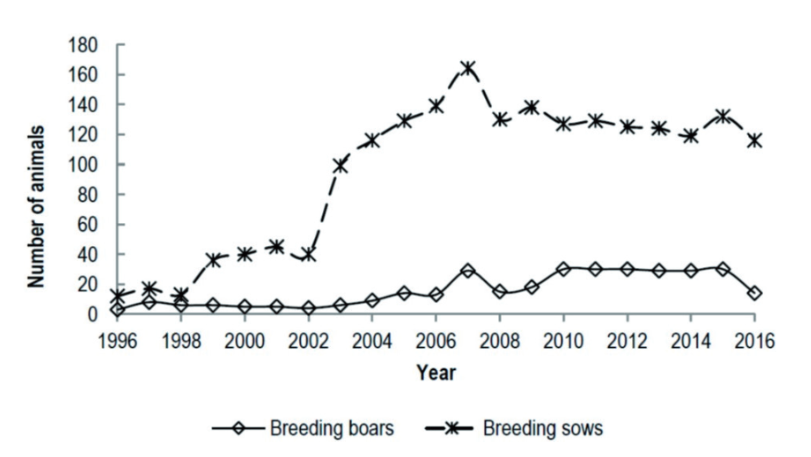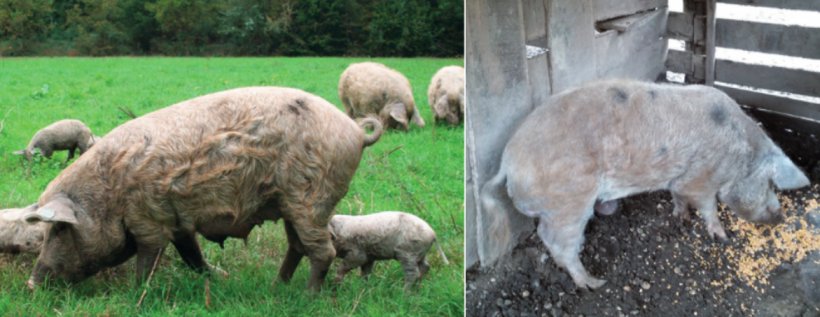History and current status of the breed
Turopolje pig is a native Croatian breed, created during the early Middle Ages in Turopolje region near Zagreb in Central Croatia. It is a medium-sized, primitive, fatty-type pig breed. As it developed over a long period of time, the breed perfectly adapts to its natural environment, primarily continental climate conditions and lowland forest ecosystems. Due to the modest demands, resistance and good adaptation to local marsh pastures and oak and beech forests, the Turopolje pig breed for centuries has been an important food source for the local population. However, the rapid penetration of imported lean pigs in the second half of the twentieth century, as well as the ban of forest grazing, significantly reduced the interest in this breed. The result was an emerging decrease of the population size, and since 1996, the Turopolje pig breed is under the state protection. Unfortunately, despite the support the Turopolje pig breed is still endangered, and the renewal of the population has been very slow. Census of Turopolje pig breed is presented in Figure 1. Presently, there are only 12 registered farms of Turopolje pigs with about 116 breeding sows and 14 boars in the latest available status (August 2016). In the past, the meat of Turopolje pig was considered better than meat of other pig breeds, but today its use is sporadic and almost completely replaced with the meat of modern pig breeds and hybrids. However, as a part of the current trends in the protection of local breeds and their sustainable farming systems, it becomes justified to review the breeding of Turopolje pig breed for production of meat and local meat products. Renovation of traditional link between breed and its products and their technological and marketing development may, by itself, represent the best way for recovery and long-term preservation of Turopolje pig breed on economically sustainable base.


Exterior phenotypic characteristics
The Turopolje pig breed morphology information is summarized in Table 1. It is a medium-size breed with distinctive sporadic black spots on a white or gray coat, mostly curly hair and drooping, half-folded ears (Figure 2). Head is medium long with slightly concave profile and sturdy snout, which ensures a good rooting ability. Body constitution is firm, but not muscular. Legs are high, with solid joints. Frame is short and not too deep. Back is medium in width and slightly lowered at croup; shoulders and hams are less developed. Breed is lively tempered and curious.
Table 1. Summary of morphology information on Turopolje pig breed.
| Measurement (average) | Adult male | Adult female |
|---|---|---|
| Body weight (kg) | 106.0 | 96.6 |
| Body length1 (cm) | 70.0 | 72.7 |
| Head length (cm) | 28.0 | 27.0 |
| Tail length (cm) | 30.0 | 29.9 |
| Ear length | 22.0 | 22.5 |
| Chest girth (cm) | 116.0 | 111.2 |
| Height at withers (cm) | 67.0 | 65.2 |
1Measured from the tip of the nose to the starting point of the tail.

Geographical distribution and production system
Turopolje refers to a plain extending over a 45-km-long and 23-km-wide alluvial plateau, occupying an area of about 600 km2, with an average altitude of 110 m above sea level. It is located between Posavina (wetland plains along the Sava River) in the north and the Vukomeričke gorice (low altitude hills) in the south. The Odra River flows through it with the Lomnica tributary. Characterized by lowland oak forests, periodically flooded pastures and continental climate, Turopolje has always been suitable for outdoor livestock production, especially pig breeding. In the past Turopolje pig breed spread from Turopolje to Sisak and Draganić, later to the parts of Slavonija and Podravina and all the way to the south-western parts of Hungary. However, with the transition from extensive to intensive pig production in the mid of twentieth century, its farming drastically reduced and the breed almost disappeared. Today, Turopolje pig is reared only in a few localities, mainly in Turopolje forest and Nature Park Lonjsko Polje, where traditional way of pig farming has been maintained. Basically, it comprises a low-input technology of animal housing and feeding in a fully outdoor system on pasture at local forests and marsh meadows. Pigs are provided with only a simple shelter, water and some supplemented feed (e.g., 0.5–2 kg of corn per animal daily), while the majority of animal’s diet is supplied from natural resources (e.g., acorn, grass, worms, snails, shellfish, etc.). Finishing at high-grain diet, prior to slaughter is usual. Indoor housing and intensive production systems are rarely practiced.
Productive performance
Reproductive traits
The age of sows at first parturition is approximately 23 months. Sows of Turopolje pig breed have 0.5–2.5 litters per year with 4.5–6.7 piglets of 1.2 kg live body weight. The percentage of stillborn piglets and piglet mortality rate until weaning is relatively high in the considered studies (5.2–26.5%). Duration of lactation is prolonged in comparison to modern intensive systems to 42 days, which leads to a longer farrowing interval (312 days on average), but not to a higher weaning weight (4.2 kg).
Growth performance
In Turopolje pig breed, studies provided only growth rate in period of lactation and the overall growth rate for the whole fattening stage (defined as overall). It should also be noted that majority of collected studies simulated practical conditions of the production systems used and that only a smaller part of the studies actually aimed at evaluating the breed potential for growth. The average daily gain in Turopolje pigs during lactation is 101 g/day, which is less than expected in modern pig breeds. Also, an average value obtained for the overall fattening stage is characterized by a considerably slower growth rate (429 g/day) than modern pig breeds. In the context of the evaluation of growth performance, it is also of interest to observe the extreme values, because it can be assumed that the maximum figures exhibit the growth potentials of Turopolje pigs in ad libitum conditions of feeding (≈ 556 g/day in the overall fattening stage). Average daily feed intake reported was around 2.0 kg/day in the overall fattening period.
Body composition and carcass traits

In considered studies, pigs of Turopolje breed were slaughtered at approximately 437 days of age (140–679 days) and average 96 kg live weight. Dressing yield was around 80% and lean meat content around 40.0% (SEUROP classification or dissection). The backfat thickness values were measured at the position of withers averaged 57 mm, at the level of the last rib 37 mm and at the level of gluteus medius muscle 34 mm. Muscularity was measured as loin eye area averaged 23 cm2 and as muscle thickness above gluteus medius 48 mm.
Meat quality
In the studies reporting meat quality of Turopolje pigs, pH measured in longissimus muscle at 45 min and 24 h post-mortem were around 6.1 and 5.68, respectively. The intramuscular fat content ranged from 2.2 to 5.8 (3.7% in average), and color measured in CIE L*, a* and b* color space was 44.6, 19.3 and 5.7 for L, a* and b*. SFA, MUFA and PUFA content of intramuscular fat in longissimus muscle in the considered studies were around 38, 51 and 11%, whereas SFA, MUFA and PUFA content of back fat tissue were approximately 38, 49 and 13%, respectively.
Use of breed and main products
Resilient and capable of foraging, Turopolje pig breed has always been able to survive in free range, which makes it particularly suitable for low-input, extensive production systems. Its use today represents a potential alternative to intensive farming, and it should be intended primarily for production of pork meat and products of premium quality. Meat is darker and redder in color than in standard pork, with fine muscular texture, which seems to be characteristic for this breed. There is a higher level of accumulation of fat tissue, especially in the subcutaneous area, and between the muscles. Meat of Turopolje pigs in today’s gastronomy is mainly used in special occasions for the preparation of various local food specialties (e.g., “turopoljska kotlovina”, goulash, various pork roasts). It is also suitable for processing in typical meat products (e.g., dry-cured ham, bacon, dry-fermented sausages, etc.), which are highly appreciated by local consumers but for now rarely available in the market. In 2017, the breeding association “Plemenita Opčina Turopoljska” applied for the registration of fresh meat from Turopolje pig with the protected designation of origin (PDO) label, and the procedure is underway at national level.
Acknowledgements
The research was conducted within the Project TREASURE, which has received funding from the European Union’s Horizon 2020 research and innovation pro-gramme under grant agreement No 634476. The content of this paper reflects onlythe author’s view, and the European Union Agency is not responsible for any use that may be made of the information it contains.
Danijel Karolyi, Zoran Luković, Krešimir Salajpal, Dubravko Škorput, Ivan Vnučec, Željko Mahnet, Vedran Klišanić and Nina Batorek-Lukač (February 6th 2019). Turopolje Pig (Turopoljska svinja), European Local Pig Breeds - Diversity and Performance. A study of project TREASURE, Marjeta Candek-Potokar and Rosa M. Nieto Linan, IntechOpen, DOI: 10.5772/intechopen.83782. Available from: https://www.intechopen.com/books/european-local-pig-breeds-diversity-and-performance-a-study-of-project-treasure/schw-bisch-h-llisches-pig



